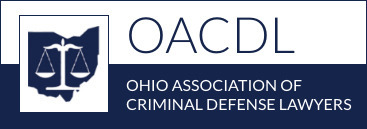Complete Story
OACDL Calls for Prompt and Effective Action to Limit Spread of COVID-19 in Jails, Prisons and Courts
Ohio Association of Criminal Defense Lawyers Calls for Prompt and Effective Action
to Limit Spread of COVID-19 in Ohio’s Jails, Prisons and Courts
The COVID-19 pandemic is well-documented. The pandemic lead Ohio Governor Mike DeWine to declare a state of emergency on March 9, 2020.[i] On March 13, 2020, President Donald Trump proclaimed the COVID-19 outbreak constitutes a national emergency.[ii] According to the Ohio Director of Health, there are approximately 100,000 Ohioans carrying the virus, with that number expected to double every six days.[iii] The State issued orders restricting large gatherings and closing schools. The State subsequently ordered the closing of restaurants, bars, fitness centers, recreation centers, bowling alleys, indoor waterparks, movie theaters and trampoline parks.[iv] The rationale behind the closings is the implementation of social distancing to decrease the spread of the virus.
The spread of the virus is of particular concern for workers and inmates in Ohio’s jails and prisons. Viruses enter jails and prisons in various ways.[v] Preventing the spread of a virus in a penal institution involves unique difficulties.[vi] Jails and prisons, with communal confinement in close quarters, are essentially a ‘cruise ship’ environment. In addition, the large number of people going in and out of the facilities makes virus introduction and transmission even more likely than on cruise chips. We have already seen examples of rapid COVID-19 infection in China and Iran. In Ohio, we will see the coronavirus spread rapidly throughout our jails and prisons unless our officials take prompt and effective action.
The Ohio Association of Criminal Defense Lawyers (OACDL) calls upon Ohio government officials to take the following prompt and effective action:
- At bail hearings, issue recognizance bonds in all cases unless there is clear and convincing evidence that recognizance release would present a substantial risk of harm
- Decline to issue “failure to appear” (capias) arrest warrants and instead reschedule court appearances
- If requested by defense counsel, waive defendants' appearances for all pretrial hearings
- Change all probation/community control and pretrial supervision meetings to phone reporting
- Extend deadlines for court-ordered classes, community service, and community control conditions which require in-person attendance
- Cancel or postpone probation/community control violation hearings if the alleged violation is not a new criminal offense
- Ensure defendants in custody receive a speedy trial as mandated by constitutions and statutes
- Impose sentences with a presumption the sentence will be noncustodial unless there is clear and convincing evidence that release would present a substantial risk of harm
- Release all incarcerated individuals who are in a high-risk category for being infected with the virus (the elderly, those with asthma, cancer, heart disease, lung disease, and diabetes) unless there is clear and convincing evidence that release would present a substantial risk of harm
- For individuals incarcerated for misdemeanor offenses, release them and place them on community control sanctions unless there is clear and convincing evidence that release would present a substantial risk of harm
- Provide soap and CDC-recommended hand sanitizer to incarcerated individuals and all workers at jails and prisons
- Complete comprehensive sanitation of jails, prisons, and transport vehicles
- Quarantine those infected with the virus in a way which protects others from infection and provides the infected person with appropriate medical care
- Limit contacts, stops, and warrant enforcement to situations in which there is an imminent concern for public safety
- Limit arrests to situations in which it is clearly necessary for safety and instead issue summonses whenever arrest is not clearly necessary for safety
- Screen arrested persons for COVID-19 exposure before transportation to a jail or booking facility
- Provide all patrol officers with sufficient sanitizing products
- Share the plan for combatting COVID-19 in the jails and prisons with full transparency so the details of the plan are known by courts, law enforcement, criminal justice personnel, incarcerated persons, their families, and the community
The OACDL recognizes these requests are extensive. So is the spread of COVID-19. Individuals in Ohio’s jails and prisons cannot currently engage in social distancing to decrease the spread of the virus. Neither can the individuals who work in the jails and prisons. By promptly implementing the proposals related to incarceration, government officials can reduce the number of incarcerated persons without endangering the public, and social distancing can be more of a reality in our jails and prisons. By promptly implementing the proposals unrelated to incarceration, government officials can protect persons involved in the court system. Ohio is leading the way in combatting the spread of COVID-19 for the general public, and our hope is Ohio will also lead the way in protecting incarcerated persons, jail/prison workers, and everyone in the court system.
[i] The declaration can be found online here: State of Emergency Declaration
[ii] The proclamation can be found on the Whitehouse website’s presidential actions page
[iii] Reported in the Columbus Dispatch article ‘Coronavirus in Ohio: The math behind the infection’s spread’
[iv] The orders can be found on the ODH website page with public health orders
[v] Ndeffo-Mbah et. al., “Dynamic Models of Infectious Disease Transmission in Prisons and the General Population,” Epidemiol Rev.; 40(1): 40-57 (June 2018)
[vi] Turner and Levy (Aug. 2009), “Pandemic Influenza Preparedness and Response Planning: Guidelines for Community Corrections,” American Probation and Parole Association

